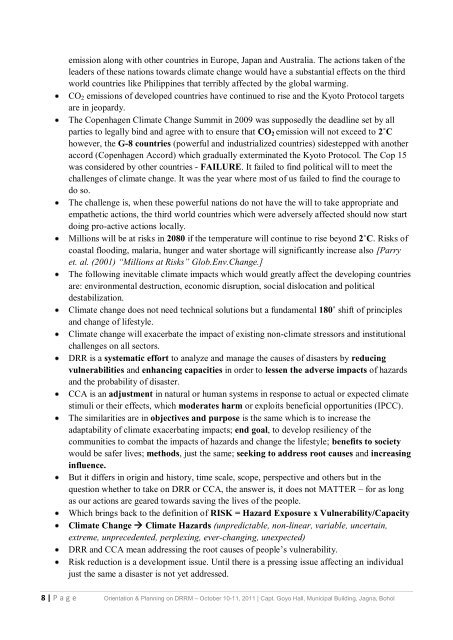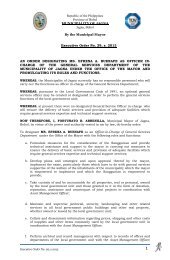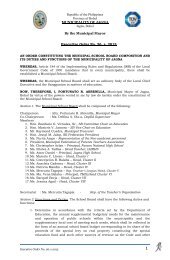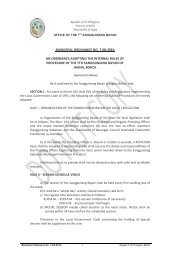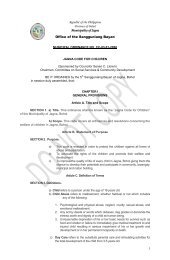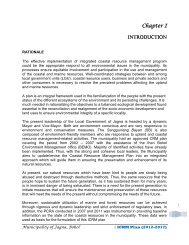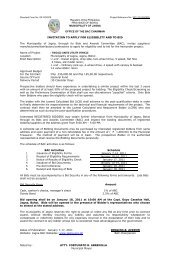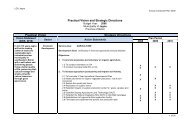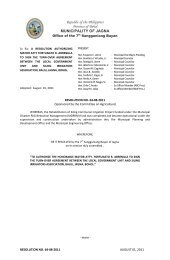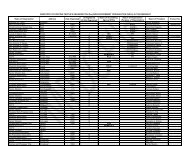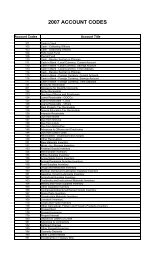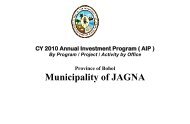DRRM Orientation to Punong Barangays of Jagna
DRRM Orientation to Punong Barangays of Jagna
DRRM Orientation to Punong Barangays of Jagna
Create successful ePaper yourself
Turn your PDF publications into a flip-book with our unique Google optimized e-Paper software.
emission along with other countries in Europe, Japan and Australia. The actions taken <strong>of</strong> the<br />
leaders <strong>of</strong> these nations <strong>to</strong>wards climate change would have a substantial effects on the third<br />
world countries like Philippines that terribly affected by the global warming.<br />
CO 2 emissions <strong>of</strong> developed countries have continued <strong>to</strong> rise and the Kyo<strong>to</strong> Pro<strong>to</strong>col targets<br />
are in jeopardy.<br />
The Copenhagen Climate Change Summit in 2009 was supposedly the deadline set by all<br />
parties <strong>to</strong> legally bind and agree with <strong>to</strong> ensure that CO 2 emission will not exceed <strong>to</strong> 2˚C<br />
however, the G-8 countries (powerful and industrialized countries) sidestepped with another<br />
accord (Copenhagen Accord) which gradually exterminated the Kyo<strong>to</strong> Pro<strong>to</strong>col. The Cop 15<br />
was considered by other countries - FAILURE. It failed <strong>to</strong> find political will <strong>to</strong> meet the<br />
challenges <strong>of</strong> climate change. It was the year where most <strong>of</strong> us failed <strong>to</strong> find the courage <strong>to</strong><br />
do so.<br />
The challenge is, when these powerful nations do not have the will <strong>to</strong> take appropriate and<br />
empathetic actions, the third world countries which were adversely affected should now start<br />
doing pro-active actions locally.<br />
Millions will be at risks in 2080 if the temperature will continue <strong>to</strong> rise beyond 2˚C. Risks <strong>of</strong><br />
coastal flooding, malaria, hunger and water shortage will significantly increase also [Parry<br />
et. al. (2001) “Millions at Risks” Glob.Env.Change.]<br />
The following inevitable climate impacts which would greatly affect the developing countries<br />
are: environmental destruction, economic disruption, social dislocation and political<br />
destabilization.<br />
Climate change does not need technical solutions but a fundamental 180˚ shift <strong>of</strong> principles<br />
and change <strong>of</strong> lifestyle.<br />
Climate change will exacerbate the impact <strong>of</strong> existing non-climate stressors and institutional<br />
challenges on all sec<strong>to</strong>rs.<br />
DRR is a systematic effort <strong>to</strong> analyze and manage the causes <strong>of</strong> disasters by reducing<br />
vulnerabilities and enhancing capacities in order <strong>to</strong> lessen the adverse impacts <strong>of</strong> hazards<br />
and the probability <strong>of</strong> disaster.<br />
CCA is an adjustment in natural or human systems in response <strong>to</strong> actual or expected climate<br />
stimuli or their effects, which moderates harm or exploits beneficial opportunities (IPCC).<br />
The similarities are in objectives and purpose is the same which is <strong>to</strong> increase the<br />
adaptability <strong>of</strong> climate exacerbating impacts; end goal, <strong>to</strong> develop resiliency <strong>of</strong> the<br />
communities <strong>to</strong> combat the impacts <strong>of</strong> hazards and change the lifestyle; benefits <strong>to</strong> society<br />
would be safer lives; methods, just the same; seeking <strong>to</strong> address root causes and increasing<br />
influence.<br />
But it differs in origin and his<strong>to</strong>ry, time scale, scope, perspective and others but in the<br />
question whether <strong>to</strong> take on DRR or CCA, the answer is, it does not MATTER – for as long<br />
as our actions are geared <strong>to</strong>wards saving the lives <strong>of</strong> the people.<br />
Which brings back <strong>to</strong> the definition <strong>of</strong> RISK = Hazard Exposure x Vulnerability/Capacity<br />
Climate Change Climate Hazards (unpredictable, non-linear, variable, uncertain,<br />
extreme, unprecedented, perplexing, ever-changing, unexpected)<br />
DRR and CCA mean addressing the root causes <strong>of</strong> people’s vulnerability.<br />
Risk reduction is a development issue. Until there is a pressing issue affecting an individual<br />
just the same a disaster is not yet addressed.<br />
8 | P a g e <strong>Orientation</strong> & Planning on <strong>DRRM</strong> – Oc<strong>to</strong>ber 10-11, 2011 | Capt. Goyo Hall, Municipal Building, <strong>Jagna</strong>, Bohol


